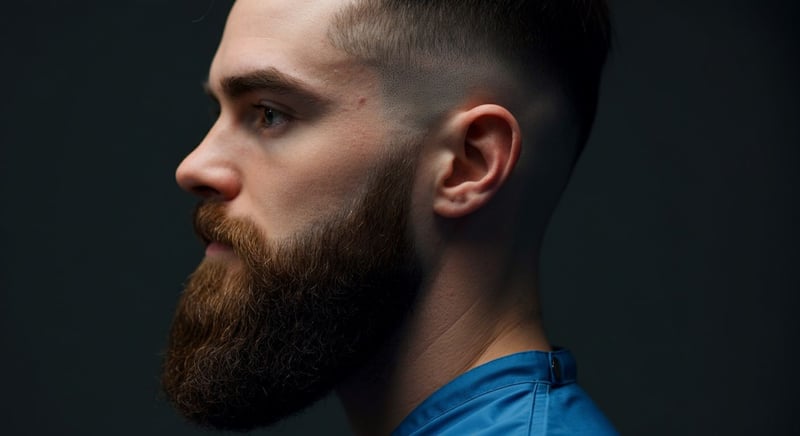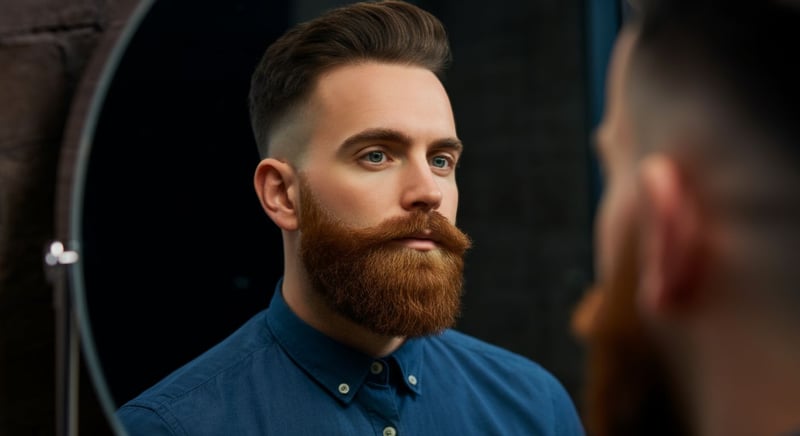Unlock Your Dream Beard: A Complete Transplant Guide
Transform your look with a beard transplant. Explore techniques, recovery, and maintenance tips for a fuller beard.
In recent years, the pursuit of the perfect beard has led many to explore advanced hair restoration options. Whether you're struggling with patchy growth or seeking a more robust look, a beard transplant could be your ideal solution. But how do you determine the best approach for transforming your facial hair dreams into reality? Let’s delve into the comprehensive world of beard transplants, where precision meets personalization to unlock your ideal look.
Beard Transplant: Is It the Right Choice for You?
Understanding Your Motivations for a Beard Transplant
Deciding whether a beard transplant is right for you begins with exploring your personal motivations. Genetic factors often play a significant role in patchy or thin beard growth, influencing many to seek a fuller, more defined look. Aesthetic goals, such as achieving a specific beard style or enhancing facial symmetry, are also key drivers.
A well-executed facial hair transplant can be life-changing, especially for those self-conscious about their appearance. Consider how a fuller beard might impact your self-esteem and social interactions. Many individuals report increased confidence and a more positive self-image following the procedure. The best beard transplant clinics near me offer personalized consultations to assess your suitability and aesthetic goals to ensure that the beard restoration aligns with your expectations.
Factors to Consider Before Proceeding
- Genetic Predisposition: Understand that genetics significantly influence hair growth patterns. A beard transplant can overcome these limitations by transplanting hair follicles from areas with healthy growth.
- Aesthetic Expectations: Define your desired beard style and density. Realistic goals are crucial for satisfaction. Surgeons at estethica Global can provide examples of beard transplant before and after pictures to help refine expectations.
- Overall Health: Ensure you are in good health. Certain medical conditions might affect the success and recovery of the transplant. A comprehensive health assessment is typically required before the procedure.
Assessing Realistic Outcomes and Benefits
- Patchy Growth Repair: A primary benefit is filling in areas of sparse or uneven growth, creating a more uniform and aesthetically pleasing beard.
- Achieving Desired Thickness: For those with naturally thin beards, a transplant can add significant density, leading to a fuller and more robust appearance.
- Camouflaging Scars: Facial hair transplants can also effectively cover facial scars from injuries or previous surgeries, enhancing overall facial aesthetics.
The impact of a successful beard transplant extends beyond mere aesthetics. It can address deep-seated insecurities and significantly improve one's quality of life. Understanding the potential benefits and having realistic expectations is crucial when considering this procedure. Many seek a beard surgeon at estethica Global in Istanbul to explore the potential of a beard transplant.

FUE vs. DHI: Choosing Your Ideal Beard Restoration Technique
Exploring the Nuances of FUE in Beard Transplants
Follicular Unit Extraction (FUE) involves extracting individual hair follicles directly from the donor area, typically the back of the scalp, using small, precise punches. This method minimizes scarring and allows for a more natural-looking beard restoration. The extracted follicles are then meticulously implanted into the recipient area, following the natural growth pattern of facial hair. estethica leverages advanced FUE techniques to ensure high graft survival rates and optimal aesthetic outcomes.
The FUE method is particularly beneficial for patients seeking to correct patchy beard growth or enhance overall beard density. It offers flexibility in selecting the finest hair follicles, which are ideal for creating a soft, natural-looking beard. This precision also extends to designing the beard line, allowing for customized results that align with the patient's facial structure and aesthetic preferences. The best beard transplant clinics near me, including estethica, prioritize FUE for its minimal invasiveness and superior aesthetic control.
DHI Advantages in Facial Hair Restoration
- Direct Implantation: DHI uses a specialized tool to simultaneously create an incision and implant the hair follicle, reducing the time the follicles are outside the body.
- Enhanced Precision: The DHI technique allows for precise control over the angle, depth, and direction of hair placement, crucial for mimicking natural beard growth patterns.
- Improved Graft Survival: Because of the swift implantation process, DHI can lead to higher graft survival rates, ensuring denser and more consistent beard coverage.
FUE vs. DHI: Tailoring the Technique to Your Needs
- Assessment: estethica begins with a thorough assessment of your facial structure, existing hair growth, and aesthetic goals to determine the most suitable technique.
- Customization: Based on the assessment, the FUE or DHI method is tailored to address specific areas of concern, whether it's filling gaps, defining the beard line, or increasing overall density.
- Artistic Approach: Regardless of the technique chosen, estethica's surgeons employ an artistic approach to ensure the transplanted beard complements your features and looks entirely natural.
The choice between FUE and DHI depends largely on individual needs and the specific characteristics of the patient’s hair and skin. Both techniques have proven successful in creating natural-looking and dense beards. At estethica, experienced surgeons carefully evaluate each patient to determine which method will yield the best possible outcome, ensuring optimal satisfaction with their facial hair transplant.

The Journey to a Fuller Beard: What to Expect Post-Transplant
Immediate Post-Op Care and Initial Expectations
Immediately following your beard transplant at estethica Global, diligent care is crucial for optimal graft survival. The initial days involve gentle cleansing of the recipient area to prevent infection and promote healing. Swelling and redness are normal and usually subside within a week. Patients are advised to avoid strenuous activities and direct sun exposure to protect the newly implanted follicles during this fragile period. Adhering closely to post-operative instructions ensures the best possible outcome for your facial hair transplant.
During this time, it's important to manage expectations. The transplanted hairs will initially fall out within the first few weeks—this is a natural part of the hair growth cycle and not a cause for concern. The new hair growth will begin in approximately three to four months. estethica provides detailed instructions and support throughout this period, ensuring patients feel informed and reassured about the process. This careful aftercare significantly impacts the long-term success and aesthetic appeal of the beard restoration.
Enhancing Growth with Additional Care
- PRP Therapy: Platelet-Rich Plasma (PRP) therapy can stimulate hair growth by using the patient’s own blood platelets to encourage follicle regeneration.
- Regular Check-ups: Routine follow-up appointments allow the clinic to monitor progress and address any concerns promptly.
- Proper Nutrition: A balanced diet rich in vitamins and minerals supports overall hair health and can enhance the growth of transplanted follicles.
Realistic Timelines and Long-Term Results
- Initial Growth (3-4 Months): New hair growth typically starts around three to four months post-transplant, with hairs appearing thin and soft.
- Maturation Phase (6-12 Months): The transplanted hairs thicken and mature, achieving their final density and texture.
- Full Results (12-18 Months): The complete aesthetic result is usually visible after 12 to 18 months, showcasing a fully grown, natural-looking beard.
Patience is key throughout this journey. While the initial stages may require diligent care and patience, the final result of a full, natural-looking beard can be transformative. Proper aftercare, combined with realistic expectations and ongoing support from estethica, helps ensure satisfaction with your beard transplant. Many patients find the enhanced facial aesthetics significantly boost their confidence and self-esteem, making the journey well worth the commitment. estethica Global’s comprehensive approach ensures high success rates and patient satisfaction with their beard restoration.

Beyond the Procedure: Maximizing Beard Hair Growth and Density
Optimizing Diet for Sustained Beard Hair Growth
A balanced and nutrient-rich diet is paramount for maintaining beard health after a beard transplant. Protein is essential as hair follicles are primarily composed of it. Vitamins, minerals, and healthy fats also play crucial roles in hair density and overall health. Incorporating a variety of whole foods supports the longevity of the transplanted grafts and enhances new hair growth. At estethica Global, we emphasize nutritional support as a vital component of post-transplant care.
Focusing on specific nutrients can further enhance beard growth. For instance, biotin, found in eggs and almonds, strengthens hair and reduces breakage. Iron, abundant in spinach and lentils, ensures oxygen is efficiently carried to hair follicles, promoting growth. Omega-3 fatty acids, present in fish and flaxseeds, nourish the hair, leading to increased shine and manageability. Paying attention to these dietary elements helps maintain the aesthetic achieved through beard restoration. The best beard transplant clinics near me, like estethica, advocate a holistic approach, combining medical expertise with lifestyle adjustments for optimal results.
Essential Grooming Practices for a Healthy Beard
- Gentle Cleansing: Use a mild, sulfate-free cleanser. Harsh chemicals can strip the hair of its natural oils, leading to dryness and damage.
- Regular Moisturizing: Apply beard oil or balm. These products hydrate the hair and skin underneath, preventing itchiness and promoting a healthy environment for growth.
- Careful Trimming: Trim stray hairs with precision. Avoid over-trimming, which can lead to an uneven or unnatural look. Seek guidance from experienced beard surgeon regarding maintenance.
Lifestyle Modifications to Support Beard Density
- Stress Management: Chronic stress can negatively impact hair growth. Techniques such as meditation, yoga, or regular exercise can help manage stress levels.
- Adequate Sleep: Sufficient sleep allows the body to repair and regenerate, including hair follicles. Aim for 7-8 hours of quality sleep each night.
- Hydration: Drinking plenty of water keeps the hair and skin hydrated, promoting overall health and vitality. Staying hydrated can help improve beard hair growth.
Lifestyle adjustments can significantly influence the health and density of a transplanted beard. Avoiding smoking, which restricts blood flow to hair follicles, is crucial. Regular exercise boosts circulation, ensuring hair follicles receive adequate nutrients. A holistic approach that combines medical care with lifestyle modifications ensures the transplanted beard thrives, enhancing the results of your facial hair transplant. Many patients share beard transplant before and after pictures highlighting the impact of proper care.
Advanced FUE and DHI Techniques Achieving Natural-Looking Beard Transplants
Personalized Care and Comprehensive Support for Successful Beard Transplants
Frequently Asked Questions
What is a Beard Transplant and who is a good candidate?
What are the main differences between FUE and DHI techniques for a Facial Hair Transplant?
How long does it take to see the full results after a Beard Restoration procedure?
What can I do to maximize beard hair growth and density after a Beard Transplant?
Questions about estethica's advanced aesthetic and healthcare solutions?
📞 Call for a Free Consultation!